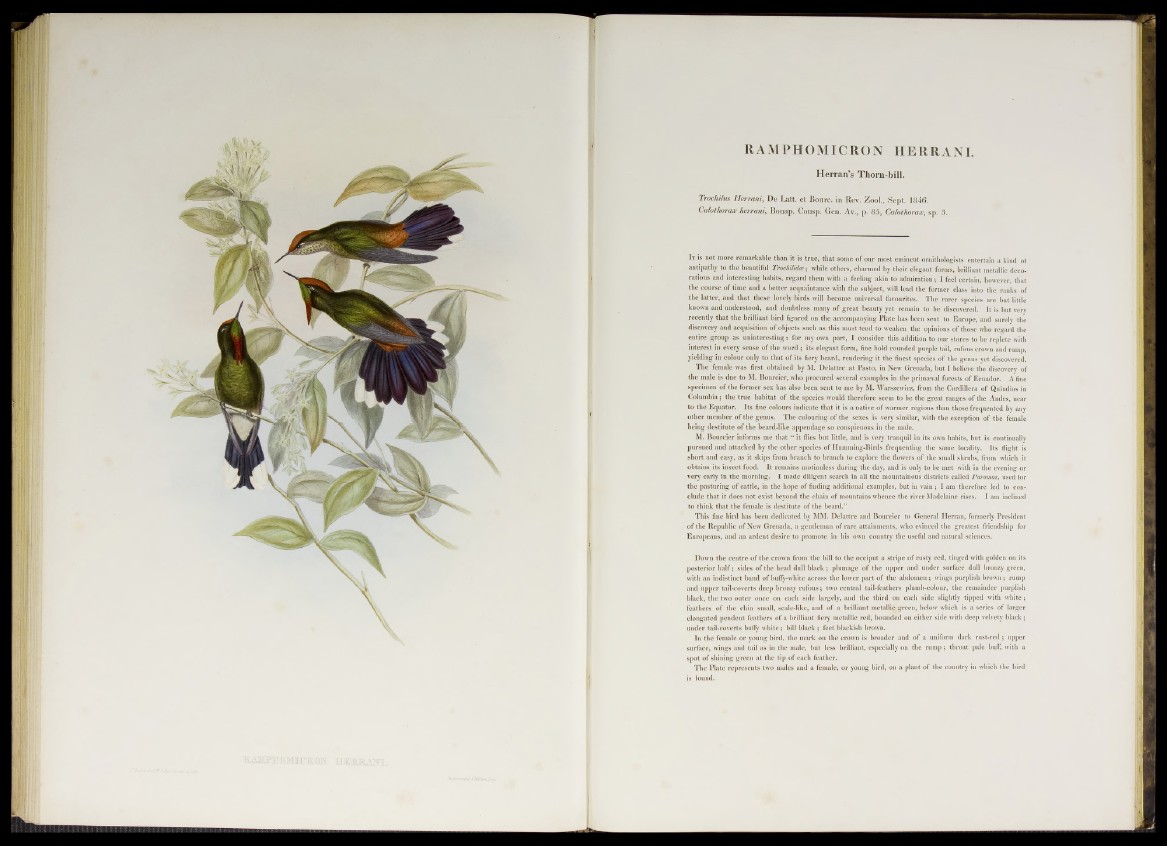
RAMPHOMICRON HERRANI.
Herran’s Thorn-bill.
Trochilus Herrani, De Latt. et Bourc. in Rev. Zool., Sept. 1846.
Calothorax herrani, Bonap. Consp. Gen. Av., p. 85, Calothorax, sp. 3.
It is not more remarkable than it is true, that some of our most eminent ornithologists entertain a kind ot
antipathy to the beautiful TrocMMce; while others, charmed by their elegant forms, brilliant metallic decorations
and interesting habits, regard them with a feeling akin to admiration; I feel certain, however, that
the course of time and a better acquaintance with the subject, will lead the former class into the ranks of
the latter, and that these lovely birds will become universal favourites. The rarer species are but little
known and understood, and doubtless many of great beauty yet remain to be discovered. It is but very
recently that the brilliant bird figured on the accompanying Plate has been sent to Europe, and surely the
discovery and acquisition of objects such as this must tend to weaken the opinions of those who regard the
entire group as uninteresting: for my own part, I consider this addition to our stores to be replete with
interest in every sense of the word ; its elegant form, fine bold rounded purple tail, rufous crown and rump,
yielding in colour only to that of its fiery beard, rendering it the finest species of the genus yet discovered.
The female was first obtained by M. Delattre at Pasto, in New Grenada, but I believe the discovery of
the male is due to M. Bourcier, who procured several examples in the primaeval forests of Ecuador. A fine
specimen of the former sex has also been sent to me by M. Warszewiez, from the Cordillera of Quindios in
Columbia; the true habitat of the species would therefore seem to be the great ranges of the Andes, near
to the Equator. Its fine colours indicate that it is a native of warmer regions than those frequented by any
other member of the genus. The colouring of the sexes is very similar, with the exception of the female
being destitute of the beard-like appendage so conspicuous in the male.
M. Bourcier informs me that “ it flies but little, and is very tranquil in its own habits, but is continually
pursued and attacked by the other species of Humming-Birds frequenting the same locality. Its flight is
short and easy, as it skips from branch to branch to explore the flowers of the small shrubs, from which it
obtains its insect food. It remains motionless during the day, and is only to be met with in the evening or
very early in the morning. I made diligent search in all the mountainous districts called Paramos, used for
the pasturing of cattle, in the hope of finding additional examples, but in vain ; I am therefore led to conclude
that it does not exist beyond the chain of mountains whence the river Madelaine rises. I am inclined
to think that the female is destitute of the beard.”
This fine bird has been dedicated by MM. Delattre and Bourcier to General Herran, formerly President
of the Republic of New Grenada, a gentleman of rare attainments, who evinced the greatest friendship for
Europeans, and an ardent desire to promote in his own couutry the useful and natural sciences.
Down the centre of the crown from the bill to the occiput a stripe of rusty red, tinged with golden on its
posterior half; sides of the head dull black; plumage of the upper and under surface dull bronzy green,
with an indistinct band of buffy-white across the lower part of the abdomen ; wings purplish brown; rump
and upper tail-coverts deep bronzy rufous; two central tail-feathers plumb-colour, the remainder purplish
black, the two outer once on each side largely, and the third on each side slightly tipped with white;
feathers of the chin small, scale-like, and of a brilliant metallic, green, below which is a series of larger
elongated pendent feathers of a brilliant fiery metallic red, bounded on either side with deep velvety black;
under tail-coverts buify white; bill black ; feet blackish brown.
In the female or young bird, the mark on the crown is broader and of a uniform dark rust-red; upper
surface, wings and tail as in the male, but less brilliant, especially on the rump; throat pale buff, with a
spot of shining green at the tip of each feather.
The Plate represents two males and a female, or young bird, on a plant of the country in which the bird
is found.